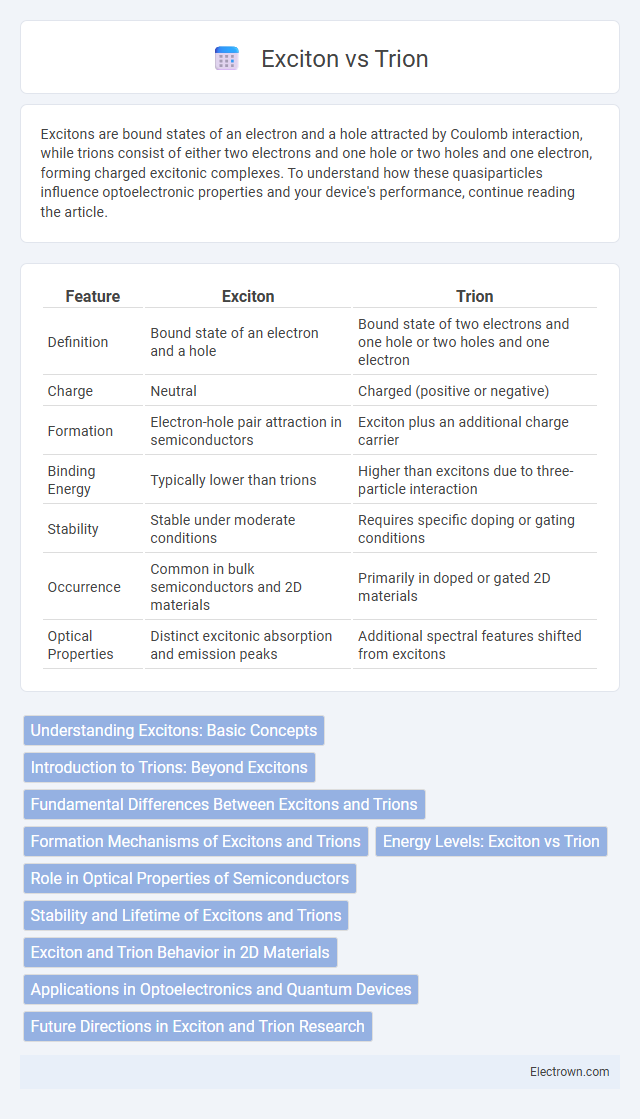Excitons are bound states of an electron and a hole attracted by Coulomb interaction, while trions consist of either two electrons and one hole or two holes and one electron, forming charged excitonic complexes. To understand how these quasiparticles influence optoelectronic properties and your device's performance, continue reading the article.
Table of Comparison
| Feature | Exciton | Trion |
|---|---|---|
| Definition | Bound state of an electron and a hole | Bound state of two electrons and one hole or two holes and one electron |
| Charge | Neutral | Charged (positive or negative) |
| Formation | Electron-hole pair attraction in semiconductors | Exciton plus an additional charge carrier |
| Binding Energy | Typically lower than trions | Higher than excitons due to three-particle interaction |
| Stability | Stable under moderate conditions | Requires specific doping or gating conditions |
| Occurrence | Common in bulk semiconductors and 2D materials | Primarily in doped or gated 2D materials |
| Optical Properties | Distinct excitonic absorption and emission peaks | Additional spectral features shifted from excitons |
Understanding Excitons: Basic Concepts
Excitons are quasiparticles formed when an electron binds with a hole in a semiconductor, creating a neutral bound state crucial for understanding optical properties. These electron-hole pairs enable efficient energy transfer and play a vital role in devices like solar cells and light-emitting diodes. Your grasp of exciton behavior is essential for exploring advanced materials in nanotechnology and optoelectronics.
Introduction to Trions: Beyond Excitons
Trions are charged quasiparticles consisting of either two electrons and one hole (negative trion) or two holes and one electron (positive trion), extending the concept of excitons, which are neutral electron-hole pairs. Unlike excitons, trions exhibit unique binding energies and optical signatures due to their additional charge, significantly influencing the electronic and optical properties of two-dimensional materials like transition metal dichalcogenides (TMDs). Understanding trions is essential for advancing optoelectronic applications, as their interactions affect photoluminescence spectra and charge transport in nanoscale semiconductors.
Fundamental Differences Between Excitons and Trions
Excitons are neutral quasiparticles formed by an electron bound to a hole within a semiconductor, while trions are charged quasiparticles consisting of either two electrons and one hole or two holes and one electron. The fundamental difference lies in their charge states, with excitons being electrically neutral and trions carrying a net positive or negative charge. Understanding these differences is crucial for interpreting optical and electronic properties in low-dimensional materials such as quantum wells and monolayer transition metal dichalcogenides.
Formation Mechanisms of Excitons and Trions
Excitons form when an electron in a semiconductor absorbs energy and is excited to the conduction band, leaving behind a positively charged hole, with the Coulomb attraction binding the electron-hole pair. Trions are charged quasiparticles created when an exciton binds with an additional electron or hole, resulting in a negatively or positively charged complex respectively. The formation of trions is favored in environments with excess charge carriers, such as doped or electrically gated materials, leading to distinct optical and electronic properties compared to neutral excitons.
Energy Levels: Exciton vs Trion
Energy levels of excitons and trions differ significantly due to their distinct charge configurations; excitons consist of one electron-hole pair with a bound energy typically in the range of tens of meV, while trions--charged excitons--include an additional charge carrier, resulting in a lower binding energy by several meV compared to excitons. Your understanding of these energy differences is crucial when analyzing semiconductor optical properties, as trions often exhibit red-shifted emission peaks relative to excitons. Precise control over these energy levels enables advancements in optoelectronic devices and quantum computing applications.
Role in Optical Properties of Semiconductors
Excitons, electron-hole pairs bound by Coulomb interaction, dominate light absorption and emission processes in semiconductors, significantly influencing photoluminescence and optical gain. Trions, charged excitons formed by an exciton coupled with an additional charge carrier, modify optical spectra by introducing new emission lines with distinct binding energies. The interplay between excitons and trions critically affects the tunability of optical properties in two-dimensional materials and semiconductor quantum wells.
Stability and Lifetime of Excitons and Trions
Excitons exhibit higher stability in pristine semiconductors with lifetimes typically ranging from picoseconds to nanoseconds, depending on the material and temperature. Trions, formed by the binding of an exciton with an additional charge carrier, generally display reduced stability and shorter lifetimes due to their charged nature, often on the order of a few picoseconds. Understanding the differences in stability and lifetime between excitons and trions is crucial for optimizing your optoelectronic device performance and tailoring material properties.
Exciton and Trion Behavior in 2D Materials
Excitons in 2D materials are electron-hole pairs bound by Coulomb interaction, exhibiting strong binding energies due to reduced dielectric screening and quantum confinement. Trions form when an exciton binds with an additional charge carrier, creating charged quasiparticles with distinct optical signatures and enhanced stability in monolayer transition metal dichalcogenides (TMDs). The manipulation of exciton and trion dynamics in 2D semiconductors enables advanced optoelectronic applications such as tunable photodetectors and valleytronic devices.
Applications in Optoelectronics and Quantum Devices
Excitons and trions are pivotal in the development of optoelectronics and quantum devices due to their unique charge and spin properties that influence light-matter interactions. Excitons, bound electron-hole pairs, are essential for efficient energy transfer in materials like transition metal dichalcogenides, enabling advances in photovoltaic cells and light-emitting diodes. Trions, charged excitons with an extra electron or hole, offer tunable optical properties that enhance quantum information processing and single-photon emission, crucial for your next-generation quantum communication technologies.
Future Directions in Exciton and Trion Research
Future directions in exciton and trion research emphasize advancing quantum computing and optoelectronic applications through enhanced understanding of their quasiparticle interactions in two-dimensional materials. Researchers aim to exploit exciton's neutral charge and trion's charged nature to achieve tunable electronic and photonic devices with increased efficiency and stability. Your developments in controlling excitonic states at room temperature could revolutionize next-generation nanoscale lasers and quantum sensors.
exciton vs trion Infographic

 electrown.com
electrown.com